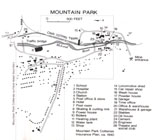The Coal Branch
The railways depended on coal to fire their locomotives and became a major user of the coal produced from the Rockies. The railways also were the primary means of transporting it to market, as the coal extracted from the mines in Alberta was used mostly in the prairie provinces.
One rich mining area came to be known as the Coal Branch, located southwest of Edson on the main line of the Grand Trunk Pacific Railway (GTP). The presence of coal in this area was known and it would have been mined earlier if the Canadian Pacific Railway had not abandoned Sandford Fleming’s surveyed route through the Yellowhead Pass in favour of the Kicking Horse Pass.1 The decision by the GTP to use the Yellowhead Pass allowed the area to be developed.
The Grand Trunk Pacific Branch Lines Company (GTPRBL) was incorporated in 1906 to build connecting lines to the National Transcontinental and the GTP into areas not reached by branches authorized to be constructed by these companies.2 Of the nearly 8000 miles authorized (most of which were never constructed) 258 miles were built in Alberta.3 One line was built from Tofield to Calgary between 1911 and 1913 with a projected extension to the United States border and the other the Coal Branch line from Bickerdike to Coalspur and Lovett (1912–13). This branch had an Alberta government guarantee of $20,000 for 58 miles.4 The line was able immediately to transport coal from the Yellowhead Pass Coal and Coke Company and the Pacific Pass Coalfields Limited.5
On February 6, 1911 the Branch Lines Company signed an agreement with the Mountain Park Coal Syndicate (superceded by the Mountain Park Coal Company Limited) to construct a railway from its line to Mountain Park.6 The cost was to be borne by the coal company that was obliged to construct, at its own expense, tracks and sidings on its property. The Branch Lines Company in turn undertook to reimburse the Syndicate for the cost of the line on the basis of tonnage shipped plus interest. On completion of the reimbursement the line would become the property of the GTPRBL. The line was opened for traffic on November 19, 1913. A similar arrangement was concluded with Luscar Collieries Limited in 1921 for a 4.91 mile spur from Leyland to Luscar opened on December 21, 1921.7
The Coal Branch was divided into two districts—Mountain Park and Coalspur.8 The community of Coalspur was a railway centre where the GTPRBL built a round house and repair services for the locomotives and cars.9 The quality of the coal differed between the two districts. Mountain Park’s coal was better for steaming10 and hence became dependent on the railway for 90% of its sales.11 The Coalspur coal was preferable for the domestic market although mixed with a higher grade was used by the railway that purchased about half of that mined.12 At its peak the Coal Branch accounted for about 22% of Alberta’s production.13
With the onset of the Depression in 1929 the fortunes of the Coal Branch declined. There was a reduction in the need for steam coal and all mining operations south of Foothills ceased.14 Although there was a resurgence of activity during World War II this was ended by the introduction by the railways of oil burning diesel-electric locomotives, and the growing dependence on oil and gas as the primary sources of energy for industrial and domestic use.15 By the early 1960s the region had become a series of ghost towns, except for Cadomin (limestone quarrying) and Robb (lumbering).16
Notes | Bibliography | Abbreviations
1. A. A. den Otter, “A Social History of the Alberta Coal Branch” (Thesis, Dept. of History, University of Alberta, 1967), p. 4.3. Canadian Department of Agriculture, Canadian National Railways Synoptical History, p. 337.
4. den Otter, “A Social History of the Alberta Coal Branch,” p. 19. Reference Edmonton Bulletin, 7 February 1912.
5. den Otter, “A Social History of the Alberta Coal Branch,” p. 16–17.
6. Canadian National Railways Synoptical History, p. 577.
7. Ibid., p. 578.
8. den Otter, “A Social History of the Alberta Coal Branch,” p. 72.
9. D. Lake, “The Historical Geography of the Coal Branch” (Thesis, Dept. of Geography, University of Alberta, 1967), p. 46.
10. den Otter, “A Social History of the Alberta Coal Branch,” p. 11.
11. Ibid., p. 79.
12. Ibid., p. 72.
13. Ibid., p. 96.
14. Ibid., p. 190.
15. Lake, pp. 65, 73.
16. Ibid., pp. 2–3.



